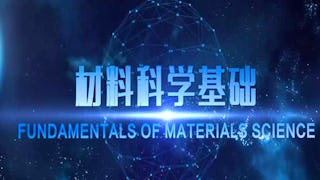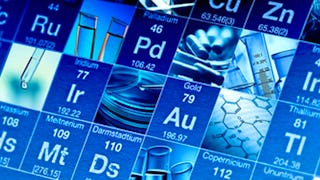Haben Sie sich jemals gefragt, warum Keramiken hart und spröde sind, während Metalle eher dehnbar sind? Warum manche Materialien Wärme oder Strom leiten, während andere isolierend sind? Warum die Zugabe einer kleinen Menge Kohlenstoff zu Eisen zu einer Legierung führt, die so viel stärker ist als das Grundmetall? In diesem Kurs lernen Sie, wie die Eigenschaften eines Materials durch seine Mikrostruktur bestimmt werden, die wiederum von der Zusammensetzung und der Verarbeitung des Materials abhängt. Dies ist der erste von drei Coursera-Kursen, die den Kurs Einführung in die Materialwissenschaft widerspiegeln, der von den meisten Studenten der Georgia Tech belegt wird. Ziel des Kurses ist es, den Studenten ein besseres Verständnis der technischen Materialien zu vermitteln, die in der Welt um sie herum verwendet werden. In diesem ersten Teil werden die Grundlagen der Materialwissenschaft behandelt, einschließlich der atomaren Struktur und Bindung, der Kristallstruktur, atomarer und mikroskopischer Defekte und nichtkristalliner Materialien wie Gläser, Gummi und Polymere.



(1,296 Bewertungen)
Kompetenzen, die Sie erwerben
- Kategorie: Physik
- Kategorie: Mechanik
- Kategorie: Naturwissenschaft
- Kategorie: Herstellungsprozesse
- Kategorie: Halbleiter
- Kategorie: Strukturelle Analyse
- Kategorie: Technik
Wichtige Details

Zu Ihrem LinkedIn-Profil hinzufügen
20 Aufgaben
Erfahren Sie, wie Mitarbeiter führender Unternehmen gefragte Kompetenzen erwerben.


Erwerben Sie ein Karrierezertifikat.
Fügen Sie diese Qualifikation zur Ihrem LinkedIn-Profil oder Ihrem Lebenslauf hinzu.
Teilen Sie es in den sozialen Medien und in Ihrer Leistungsbeurteilung.

In diesem Kurs gibt es 6 Module
Dieses Modul führt Sie in die Grundprinzipien der Materialwissenschaft ein. Zu den behandelten Themen gehören die verschiedenen allgemeinen Materialtypen (Metall, Keramik, Polymer usw.) und die mit jedem Typ verbundenen Eigenschaften, einige Methoden, die zur experimentellen Bestimmung und Quantifizierung der Eigenschaften eines Materials verwendet werden, und wie ein Werkstoffingenieur bei der Auswahl eines geeigneten Materials für eine einfache Anwendung vorgehen könnte. Dieses Modul führt auch in das Konzept der Beziehung zwischen Mikrostruktur, Verarbeitung und Eigenschaften ein, das den Kern der gesamten Materialwissenschaft bildet.
Das ist alles enthalten
14 Videos4 Lektüren2 Aufgaben
In diesem Modul werden wir die Struktur des Atoms besprechen, wie Atome miteinander interagieren und wie diese Interaktionen die Materialeigenschaften beeinflussen. Wir werden untersuchen, wie die Art der in einem Material vorhandenen Atome bestimmt, welche Art von Bindung auftritt, was die drei Arten von Primärbindungen unterscheidet - metallische, ionische und kovalente Bindungen - und welche Auswirkungen die Art der Bindung auf die Mikrostruktur des Materials hat. Sie werden lernen, wie sich Atome aufgrund ihrer Größe und ihrer Bindungen anordnen. Dieses Wissen bietet Ihnen eine Grundlage für das Verständnis der Beziehung zwischen der Mikrostruktur eines Materials und seinen Eigenschaften.
Das ist alles enthalten
18 Videos3 Lektüren4 Aufgaben
Dieses Modul behandelt die Anordnung der Atome in kristallinen Materialien. Viele der Materialien, mit denen wir täglich zu tun haben, sind kristallin, das heißt, sie bestehen aus einer sich regelmäßig wiederholenden Anordnung von Atomen. Der "Baustein" eines Kristalls, das so genannte Bravais-Gitter, bestimmt einige der physikalischen Eigenschaften eines Materials. Ein Verständnis dieser kristallographischen Prinzipien ist für die Diskussion über Defekte und Diffusion, die im nächsten Modul behandelt werden, von entscheidender Bedeutung.
Das ist alles enthalten
21 Videos2 Lektüren4 Aufgaben
Im vorigen Modul haben wir gelernt, wie die Gitterstruktur eines kristallinen Materials zum Teil die Eigenschaften dieses Materials bestimmt. In diesem Modul werden wir lernen, wie Defekte - Abweichungen von der erwarteten Mikrostruktur - ebenfalls einen großen Einfluss auf die Eigenschaften haben. Dieses Modul befasst sich mit eindimensionalen oder punktuellen Defekten, bei denen es sich um fehlende Atome (Leerstellen) oder überschüssige Atome (Zwischengitterlösung) oder um die falsche Art von Atomen an einem Gitterpunkt (Substitutionslösung) handeln kann. Aufbauend auf diesen Konzepten wird ein Teil dieses Moduls die Diffusion behandeln - die Bewegung von Atomen durch die Kristallstruktur.
Das ist alles enthalten
19 Videos2 Lektüren3 Aufgaben
Dieses Modul behandelt zwei- und dreidimensionale Defekte wie Versetzungen, Korngrenzen und Ausscheidungen. In der Diskussion wird erläutert, wie die Verformung eines Materials auf mikroskopischer Ebene abläuft. Abschließend werden wir uns damit befassen, wie das Vorhandensein und die Eigenschaften von Defekten die Festigkeit eines Materials erhöhen oder verringern können.
Das ist alles enthalten
23 Videos2 Lektüren4 Aufgaben
In diesem Modul besprechen wir Materialien, die nicht vollständig kristallin sind, wie z.B. Polymere, Gummi und Gläser. Sie werden lernen, wie sich das Fehlen von Kristallinität auf das Verhalten dieser Materialien auswirkt und welche Faktoren ihre Bildung und Eigenschaften beeinflussen. Die Lektionen beinhalten Diskussionen über die Mikrostruktur und Defekte in amorphen Materialien, partielle Kristallinität in Polymeren und Demonstrationen von Materialien, die bei unterschiedlichen Temperaturen ein duktiles und sprödes Verhalten zeigen.
Das ist alles enthalten
24 Videos3 Lektüren3 Aufgaben
Dozent

Mehr von Maschinenwesen entdecken


Georgia Institute of Technology


Shanghai Jiao Tong University


Arizona State University


Arizona State University
Warum entscheiden sich Menschen für Coursera für ihre Karriere?




Bewertungen von Lernenden
1.296 Bewertungen
- 5 stars
80,94 %
- 4 stars
15,74 %
- 3 stars
2,62 %
- 2 stars
0,23 %
- 1 star
0,46 %
Zeigt 3 von 1296 an
Geprüft am 1. Apr. 2018
It is very useful for a mechanical enginnerIm sucessfully completed this course but i cant purchase the course pls help me.....
Geprüft am 9. Juni 2020
A beautiful learning experience for me. The course was concise and effective. Thank you Coursera and Georgia Tech. Institute for this ❤
Geprüft am 5. Juni 2022
Great course content and effective knowledge related to materials.All the topics were touched related to materials and its a must have course.

Neue Karrieremöglichkeiten mit Coursera Plus
Unbegrenzter Zugang zu 10,000+ Weltklasse-Kursen, praktischen Projekten und berufsqualifizierenden Zertifikatsprogrammen - alles in Ihrem Abonnement enthalten
Bringen Sie Ihre Karriere mit einem Online-Abschluss voran.
Erwerben Sie einen Abschluss von erstklassigen Universitäten – 100 % online
Schließen Sie sich mehr als 3.400 Unternehmen in aller Welt an, die sich für Coursera for Business entschieden haben.
Schulen Sie Ihre Mitarbeiter*innen, um sich in der digitalen Wirtschaft zu behaupten.
Häufig gestellte Fragen
Der Zugang zu Vorlesungen und Aufgaben hängt von der Art Ihrer Einschreibung ab. Wenn Sie einen Kurs im Prüfungsmodus belegen, können Sie die meisten Kursmaterialien kostenlos einsehen. Um auf benotete Aufgaben zuzugreifen und ein Zertifikat zu erwerben, müssen Sie die Zertifikatserfahrung während oder nach Ihrer Prüfung erwerben. Wenn Sie die Prüfungsoption nicht sehen:
Der Kurs bietet möglicherweise keine Prüfungsoption. Sie können stattdessen eine kostenlose Testversion ausprobieren oder finanzielle Unterstützung beantragen.
Der Kurs bietet möglicherweise stattdessen die Option 'Vollständiger Kurs, kein Zertifikat'. Mit dieser Option können Sie alle Kursmaterialien einsehen, die erforderlichen Bewertungen abgeben und eine Abschlussnote erhalten. Dies bedeutet auch, dass Sie kein Zertifikat erwerben können.
Wenn Sie ein Zertifikat erwerben, erhalten Sie Zugang zu allen Kursmaterialien, einschließlich der benoteten Aufgaben. Nach Abschluss des Kurses wird Ihr elektronisches Zertifikat zu Ihrer Erfolgsseite hinzugefügt - von dort aus können Sie Ihr Zertifikat ausdrucken oder zu Ihrem LinkedIn-Profil hinzufügen. Wenn Sie die Kursinhalte nur lesen und ansehen möchten, können Sie den Kurs kostenlos besuchen.
Sie haben Anspruch auf eine vollständige Rückerstattung bis zwei Wochen nach Ihrem Zahlungsdatum oder (bei Kursen, die gerade erst begonnen haben) bis zwei Wochen nach Beginn der ersten Sitzung des Kurses, je nachdem, welcher Zeitpunkt später liegt. Sie können keine Rückerstattung erhalten, sobald Sie ein Kurszertifikat erworben haben, auch wenn Sie den Kurs innerhalb der zweiwöchigen Rückerstattungsfrist abschließen. Siehe unsere vollständigen Rückerstattungsbedingungen.
Weitere Fragen
Finanzielle Unterstützung verfügbar,

